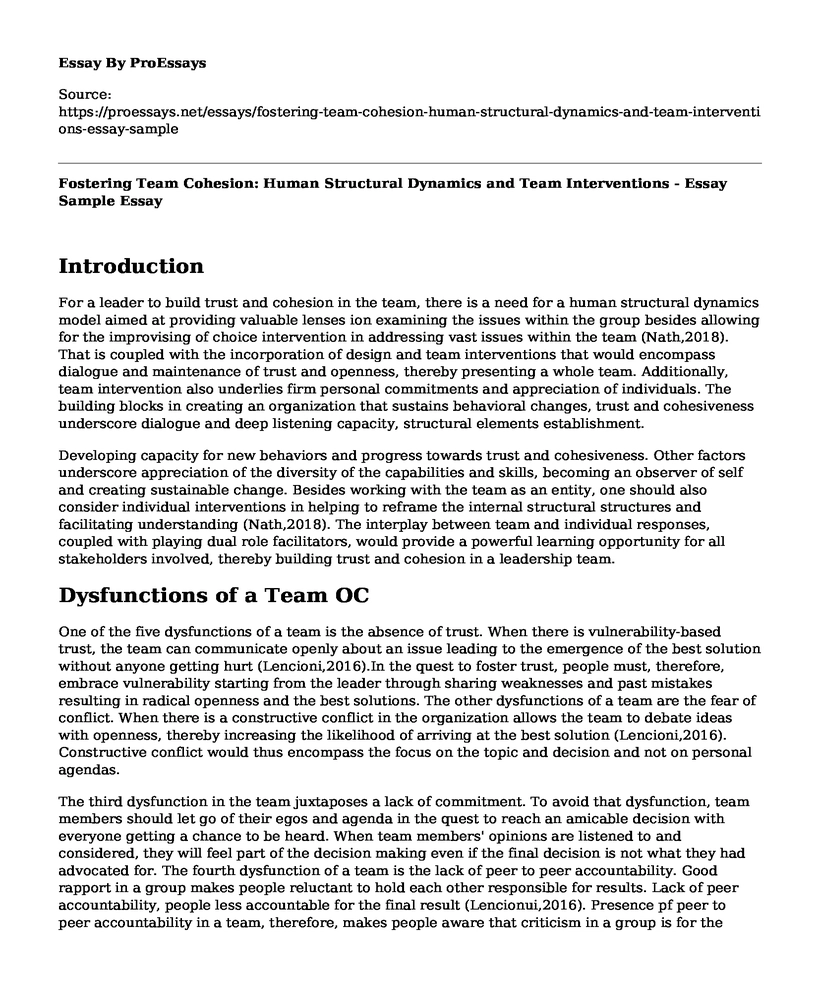Introduction
For a leader to build trust and cohesion in the team, there is a need for a human structural dynamics model aimed at providing valuable lenses ion examining the issues within the group besides allowing for the improvising of choice intervention in addressing vast issues within the team (Nath,2018). That is coupled with the incorporation of design and team interventions that would encompass dialogue and maintenance of trust and openness, thereby presenting a whole team. Additionally, team intervention also underlies firm personal commitments and appreciation of individuals. The building blocks in creating an organization that sustains behavioral changes, trust and cohesiveness underscore dialogue and deep listening capacity, structural elements establishment.
Developing capacity for new behaviors and progress towards trust and cohesiveness. Other factors underscore appreciation of the diversity of the capabilities and skills, becoming an observer of self and creating sustainable change. Besides working with the team as an entity, one should also consider individual interventions in helping to reframe the internal structural structures and facilitating understanding (Nath,2018). The interplay between team and individual responses, coupled with playing dual role facilitators, would provide a powerful learning opportunity for all stakeholders involved, thereby building trust and cohesion in a leadership team.
Dysfunctions of a Team OC
One of the five dysfunctions of a team is the absence of trust. When there is vulnerability-based trust, the team can communicate openly about an issue leading to the emergence of the best solution without anyone getting hurt (Lencioni,2016).In the quest to foster trust, people must, therefore, embrace vulnerability starting from the leader through sharing weaknesses and past mistakes resulting in radical openness and the best solutions. The other dysfunctions of a team are the fear of conflict. When there is a constructive conflict in the organization allows the team to debate ideas with openness, thereby increasing the likelihood of arriving at the best solution (Lencioni,2016). Constructive conflict would thus encompass the focus on the topic and decision and not on personal agendas.
The third dysfunction in the team juxtaposes a lack of commitment. To avoid that dysfunction, team members should let go of their egos and agenda in the quest to reach an amicable decision with everyone getting a chance to be heard. When team members' opinions are listened to and considered, they will feel part of the decision making even if the final decision is not what they had advocated for. The fourth dysfunction of a team is the lack of peer to peer accountability. Good rapport in a group makes people reluctant to hold each other responsible for results. Lack of peer accountability, people less accountable for the final result (Lencionui,2016). Presence pf peer to peer accountability in a team, therefore, makes people aware that criticism in a group is for the common good and not a personal attack, resulting from respecting among colleagues, subsequently leading to adherence to high standards of work.
Finally, the fifth dysfunction in a team underscores a lack of focus on consolidated results. There is a need to focus on team achievements rather than personal achievements. An example is Katryn's husband, who was a basketball coach and was compelled to let go of the most talented player who only cared about how much he scored, rather than when the team won or lost (Lencioni,2016). The best goals, therefore, are not only easy to measure but are also clearly defined.
References
Lencioni, P. (2016, October). Five Dysfunctions of a Team OC. BrandmanCII. [YouTubeFile].Retrieved from https://www.youtube.com/watch?v=wHpB1EBufFo
Nath, D. (2018). Building Trust and Cohesion in a Leadership Team. Systems Thinker. Retrievedfrom https://thesystemsthinker.com/building-trust-and-cohesiveness-in-a-leadershipteam/
Cite this page
Fostering Team Cohesion: Human Structural Dynamics and Team Interventions - Essay Sample. (2023, Aug 01). Retrieved from https://proessays.net/essays/fostering-team-cohesion-human-structural-dynamics-and-team-interventions-essay-sample
If you are the original author of this essay and no longer wish to have it published on the ProEssays website, please click below to request its removal:
- Implementation Plan and Objectives
- The Strategic Plan of the Tekno Electricals Company. Essay Sample.
- Teamwork in Modern Organizations
- Essay Sample on the Pay Model Strategy: The Totality of Decisions
- Analysis of the Amazon Culture - Research Paper
- Domestic Worker-Employer Relationship Paper Example
- Essay Sample on Schools' Safety: Securing Kids' Future from Intruders & Active Shooters







